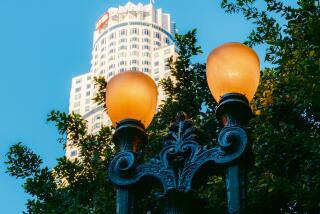Lighthouse Gets a New Beacon
- Share via
POINT PIEDRAS BLANCAS, Calif. — Winds howl, elephant seals bark and researchers scurry over tide pools here, but the abundant signs of life have long failed to benefit the lighthouse. The 127-year-old landmark fell into disrepair in the last half of the 20th century.
But in a famine-to-feast turn of events for history buffs, the Central Coast structure, not far from Hearst Castle, seems finally to be coming under a brighter light.
Not only is a new beacon being installed, but the Victorian-era lighthouse is due for a restoration and management change that is expected to improve its appearance and, probably, open it to the public for the first time.
In a colorful ceremony under overcast skies Saturday, a crowd of 240 invited guests witnessed the U.S. Bureau of Land Management take control of the site from the U.S. Coast Guard.
“We’re just tickled to death,” said Kathe Tanner, a member of the local historical society and a writer for the area weekly newspaper. “The lighthouse is really too big for a group as small as ours to manage. But with the BLM in charge, I think we are considered a junior partner, maybe a real helpful munchkin partner.”
The bureau plans to work with lighthouse buffs and area residents to raise private funds for a new lantern room and authentic historical reconstruction of the Piedras Blancas Lighthouse costing $2.5 million to $3.5 million. Aficionados have long dreamed of a renaissance for the lighthouse, which was built on a point that Spanish explorer Juan Rodriguez Cabrillo named for its white rocks in 1542.
The current plans are a far cry from expectations just three years ago, when the bright beacon that blinked into the night for 25 miles burned out. The Coast Guard replaced it with a relatively dim bulb, which reached just 10 miles.
After howls of protest from area residents, Rep. Lois Capps (D-Santa Barbara) put pressure on the Coast Guard to turn the lighthouse over to another agency, with the goal of eventually making it accessible to the public.
“We were asked, ‘Can’t we get a bigger light in there?’ And it certainly sounded like a reasonable request to us,” Capps said.
The Bureau of Land Management took control of the 19-acre site in October. The Coast Guard had not staffed the site since 1975, though it continued to maintain the light as an aide to navigation.
That changed as the bureau took over everything, including the light, in a ceremony Saturday. The plans called for Coast Guard officials to switch off the dim, older beacon Saturday night, and for the bureau to turn on the brighter light, again making the beacon visible from 20 miles out to sea.
“The Coast Guard has such a different mission than we do,” said John Bogacki, the bureau’s lighthouse station manager at Piedras Blancas. “They provide aids to navigation and, increasingly, security, and they are really tapped out. We manage land.”
But even the bureau--which traditionally has managed range land, mines and open spaces--is taking on a new role with the administration of monuments, parks and historic properties like the lighthouse.
Bureau officials said Piedras Blancas is a natural stop for those visiting the newly established Bureau of Land Management California Coastal National Monument, which includes parts of the shoreline and publicly owned offshore rocks from Mexico to Oregon.
The three guano-covered rocks that give this site its name are owned by Hearst Corp., as is the surrounding land and the access road to the lighthouse.
Bureau officials are negotiating with Hearst to gain access so that appointment-only public tours can begin.
Bogacki is working on forming a nonprofit group called Friends of Piedras Blancas to handle fund-raising. The timeline for reconstruction depends on how much money can be raised.
“People are drawn to lighthouses, because of the serenity and safe feeling you get from them,” Bogacki said as he stood atop the 74-foot lighthouse recently, watching tourists stop along California 1 to shoot pictures of the structure. “Between the 800,000-plus visitors to Hearst Castle a year and all the people who drive Highway 1, we won’t have any trouble finding visitors.”
But Bogacki said that opening the lighthouse must not interfere with any of the extensive federal research at Piedras Blancas into everything from the California gray whale migration to sea otter health.
When the lighthouse was installed in 1875, it was the only light that mariners saw between Santa Barbara and Monterey.
“There’s no other design quite like Piedras Blancas in the country,” said Wayne Wheeler, president of the U.S. Lighthouse Society.
“We’re riding a historic preservation wave, and lighthouses are very hot right now,” he said.
Preservation has been possible because many lighthouses are isolated on public land, he said. “They were safer than many spots in our pave-over and tear-down world.”
More to Read
Sign up for The Wild
We’ll help you find the best places to hike, bike and run, as well as the perfect silent spots for meditation and yoga.
You may occasionally receive promotional content from the Los Angeles Times.






